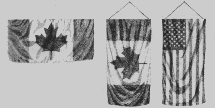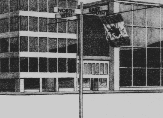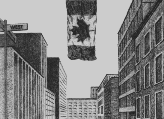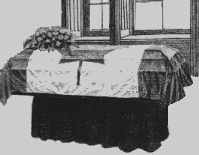Flagpole laws
Dignity of the Flag
The National Flag of Canada should be displayed only in a manner appropriate for this important national symbol; it should not be subjected to dishonour or displayed in a position inferior to any other flag or ensign. The National Flag always takes priority over all other national flags when flown on Canadian soil. The only flags to which precedence is given over the National Flag are the Queen's Personal Canadian Flag, the Governor General's Flag, the Flags of the Lieutenant Governors (within their province) and the Personal Canadian Flags of the other members of the Royal Family.
The National Flag of Canada should always be flown on its own mast or flag pole; flag protocol states that it is improper to fly two or more flags on the same mast or flag pole (for example, one beneath the other).
When the National Flag of Canada is raised or lowered, or when it is carried in a parade or review, everyone present should face the Flag, remain silent and remove their hats. Those in uniform should salute.
The National Flag of Canada, whether it be a cloth, paper or made of some other fabric or material, should never:
- Be used as a tablecloth or seat cover;
- Be used as a masking for boxes, covering a speaker's podium, draping a platform, as a barrier on a stage or platform, or in general for any decoration;
- Be used to cover a statue, monument or plaque for an unveiling ceremony;
- Have anything pinned to or sewn onto it;
- Be signed or marked in any way (A border could be attached to its outside edge, which can be marked while leaving the Flag itself untouched.);
- Be used as wearing apparel;
- Be flown in a discoloured or tattered condition;
- Be burned in effigy;
- Touch the ground;
- Be stepped on;
- Be flown upside down (except as a signal of distress in instances of extreme danger to life);
- Be dipped or lowered to the ground as a means of paying a salute or compliment to any person or thing.
Displaying the Flag
The National Flag is flown at all federal government buildings, airports, as well as military bases and establishments within and outside Canada. It may be flown by night as well as by day.
The National Flag of Canada may be displayed as follows:
Flat against a surface, horizontally and vertically
If hung horizontally, the upper part of the leaf (the points of the leaf) should be up and the stem down. If hung vertically, the flag should be placed so that the upper part of the leaf points to the left and the stem to the right from the point of view of the observer facing the Flag. Flags hung vertically should be hung so that the canton is in the upper left corner.

On a flagpole or mast
The top left (first) quarter or canton should be placed in the position nearest the top of the flagpole or mast. When carried, the Flag should be respected.
On a flag rope (halyard)
The canton should be raised as closely as possible to the top with the flag rope tight.
Suspended vertically in the middle of a street
The upper part of the leaf (the points of the leaf) should face north in an east-west street (Figure 2). The upper part of the leaf should face east in a north-south street (Figure 3).


Projected from a building
Displayed horizontally or at an angle from a window or balcony, the canton must point outward.
Affixed on a motor vehicle
The flag must be on a pole firmly fixed to the frame of the car on the front right.
Flown on ships and boats
The National Flag of Canada is the proper national colours (flag of a military unit) for all Canadian ships and boats, including pleasure craft. The Canada Shipping Act states that a Canadian ship shall hoist the flag:
- on a signal being made to her by one of Her Majesty's Canadian ships, or any ship in the service of and belonging to the Government of Canada;
- on entering or leaving any foreign port; and
- on entering or leaving any Commonwealth port if carrying 50 tonnes gross tonnage or upwards.
Foreign vessels may fly the Canadian flag as a "courtesy flag" when they are docked in a Canadian port; it is then customarily flown from the foremast.
General rules governing merchant vessels and pleasure craft are as follows:
- The flag should be worn in harbour and in territorial waters. It does not need to be worn while under way on the high seas unless the vessel wishes to identify her nationality to another ship.
- Whenever possible, the proper place for a vessel to display the national colours is at the stern; however, the flag may be flown from a gaff when at sea.
- When in harbour, the flag should be hoisted at 0800 hours (8 a.m.) and lowered at sunset.
- When a merchant ship and a warship of any nationality pass or overtake one another, the merchant ship should dip the flag as a gesture of courtesy. If on a staff, the lowest corner of the flag should be brought to the level of the rail and kept there until the salutation is acknowledged by the naval vessel. If flown from a gaff, the flag should be lowered to six feet (1.80 m) above the level of the deck, until the salute is acknowledged.
- In times of mourning, the flag may be flown at half-mast, which places the upper corner of the flag next to the staff at approximately three-quarters of full-hoist. As on land, a flag hoisted to or lowered from half-mast position must first be pulled close-up.
Sharing the same base – three flags
When only three flags are displayed, the National Flag of Canada should be at the centre. To an observer facing the display, the second-ranking flag is placed to the left of centre, and the other to the right.
A common combination of flags is the National Flag of Canada with a provincial or territorial flag, and a municipal flag or an organization's banner. In this case, the National Flag should be in the centre with the provincial/territorial flag to the left and the municipal flag/organization's banner to the right (to an observer facing the display).
When used to cover a casket at funerals
The canton should be draped over the upper left corner of the casket (Figure 4). The Flag should be removed before the casket is lowered into the grave or, at a crematorium, after the service. The flag size for a standard adult-sized casket should be 4 1/2 X 9 feet or 1.40 X 2.80 metres.

Half-masting for mourning
Flags are flown at the half-mast position as a sign of mourning.
The flag is brought to the half-mast position by first raising it to the top of the mast then immediately lowering it slowly to the half-mast position.
The position of the flag when flying at half-mast will depend on the size of the flag and the length of the flagstaff. It must be lowered at least to a position recognizably "half-mast" to avoid the appearance of a flag which has accidentally fallen away from the top of the mast. A good position for half-masting is to place the centre of the flag exactly half-way down the staff (Figure 5).

On occasions requiring that one flag be flown at half-mast, all flags flown together should also be flown at half-mast. Flags will only be half-masted on those flagpoles fitted with halyards and pulleys. Some buildings fly flags from horizontal or angled poles, without halyards, to which flags are permanently attached. Flags on these will not be half-masted.
For more information, see half-masting the National Flag of Canada.
Disposal of flags
When a flag becomes tattered and is no longer in a suitable condition for use, it should be destroyed in a dignified way.
A flag is considered to be tattered or worn when the colour has faded, it has developed a hole, or the outermost seam (fly) of the flag has become frayed. When a flag is no longer in a suitable condition for use, it should be disposed of in a dignified manner.
Disposal of such flags may be handled in the following manner:
- Return flag(s) to participating retail stores who will dispose of them;
- Flags made of natural fibres (wool, cotton, linen) should be burned in a dignified manner; privately without ceremony or public attention being drawn to the destruction of the material;
- Flags made of synthetic materiel (nylon or polyester) should be respectfully torn into strips, with each element of the flag reduced to a single colour, so that the remaining pieces do not resemble a flag. The individual pieces should then be placed in a bag for disposal – the shreds of fabric should not be re-used or fashioned into anything.
Folding the National Flag
There is a specific process for the National Flag of Canada to be folded. The Canadian flag draped over a casket symbolizes a final tribute that celebrates a life that has passed. Being laid to rest with the Flag is an honour that is not solely reserved for the funerals of soldiers, veterans, and dignitaries but for all Canadians.
Learn more about the process for the ceremonial folding of the National Flag of Canada.
